
To say that mobility is changing would be stating the obvious now that we can download an application, register on a platform, and use carsharing schemes in many cities. One such scheme is Zity carsharing. Having said this, it is always good to know where mobility is heading and how it is transforming the urban landscape and our everyday routines.
The acronym CASE appeared on the scene some time ago as a name for the vehicles of the future: Connected – Autonomous – Shared & Electric. But whatever their name, this is what the future of cars, and of mobility on roads and in the city, appears to be heading.
Connected vehicles (are already here)
When we think of connected vehicles, we get the impression that we’re talking about something in the distant future, or perhaps even in science fiction, when the truth is that most of the cars we see on the roads today already have Internet connection. This can be achieved with an embedded SIM (eSIM) on the dashboard, or with data connection through our smartphones.
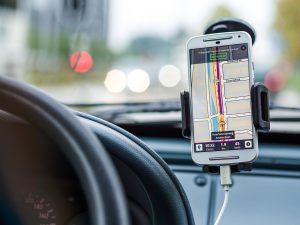
According to Hewlett Packard’s White Paper The Internet of Things and connected cars, in 2016 15% of all cars sold had on-board connection; in 2017 this had increased to 22% of all manufactured cars. In Europe, estimates are that all new vehicles in 2019 will have Internet connection, given that the eCall system, which sends out an alert in case of an accident, will be compulsory from 31 March 2018, according to the DGT (Spain’s national traffic authority).
It is highly likely that eCall will be the entry point for telecommunications companies to make use of an infrastructure of millions of vehicles looking to get connected. According to the CNMC (Spain’s National Commission on Markets and Competition), in August 2016 there were around 55 million personal SIM lines. Given that there are currently over 30 million vehicles in Spain, it seems that the market will be large enough.
It seems only natural that telecommunications companies invest in car connectivity, given that having WiFi in our car provides a certain added value, as is the case with booked service cars with driver such as Uber and Cabify, which are advertised as providing WiFi. Passengers in these cars can take the back seat, connect, and work during the trip.
Add to this the fact that dozens of digital services are also looking for their niche at the wheel and are exerting pressure to get it. Google Play Music, Spotify or iTunes, for example, are all-you-can-listen music services with a monthly fee which a user will enjoy more if able to listen to their favourite songs on the way to work.
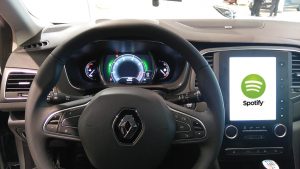
And going further still, to a concept which is almost like something taken out of science fiction, the connected vehicle will be a hugely relevant source of information for numerous applications, many of them citizen initiatives. After all, vehicles are already fitted with dozens of sensors (temperature, pressure, light, etc.) which are currently only used to feed the car’s central computer at a particular moment and are subsequently discarded.
Think of how AEMET (the Spanish state meteorological agency) collects information from 800 weather stations distributed throughout the Spanish mainland and islands, and how this can be improved if millions of cars send data every minute while on the road. Areas of application are almost limitless:
- Better understanding of the trips people make, the routes taken and the type of mobility afforded by each vehicle.
- Knowing the average occupancy of vehicles, separating GPS smartphone data from car data.
- Providing a better weather forecasting service, by connecting the multiple car sensors to the network.
- Providing this information to carsharing services (BlaBlaCar), public services (MyTaxi) or carsharing (Zity), to improve working policies for the different fleets.
- Improve research on driving habits by the DGT or other bodies.
Autonomous vehicles are already in town
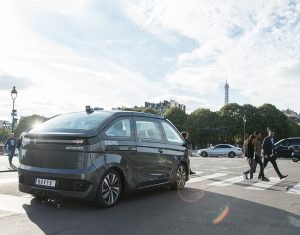
It would appear that the ultimate purpose of connectivity in cars and other vehicles such as lorries or buses is that they can eventually become autonomous vehicles, capable of driving on their own in much the same way a human would drive them. Or, in fact, better than a human. Remember autonomous cars in Minority Report (2002), I, Robot (2004) or Logan (2017)?
Autonomous driving relies on cameras which “look” at the road in ways very similar to our own eyes but from points which would be totally inaccessible to drivers. These images are processed by recognition software to “see” the signs, other cars or pedestrians.
It also relies on “senses” that us humans don’t have, such as long-distance radar to detect the vehicle in front, and to brake or accelerate accordingly; or medium-range radar to maintain appropriate distances with other road users, such as cyclists, a vulnerable group where fatal accidents, unfortunately, increased by 11% between 2016 and 2017, according to the DGT.
For the car to get a general idea of what the road is like, all the above systems, which already process and cross-check similar data, are helped by LiDAR-type lasers. These perform constant sweeps to build a 3D representation of the road. The “horns” on the autonomous taxi below, the Navya Autonom CAB, are LiDAR sensors:
We have all heard of Tesla’s electric and autonomous cars, Tesla being Elon Musk’s company. But he’s not the only one who’s been working for years on autonomous mobility, and companies such as the already mentioned Navya or Easy Mile already have public transport buses or on-demand taxis to take people from one place to another… without [human] drivers.
The above video shows Easy Mile announcing its autonomous public transport bus. In the video below, the advantages for a city of vehicles moving on their own. And not just because it is more convenient, but because they imply huge savings in space for citizens. After all, why have a car parked for 97% of its useful life, or 96.5% or 95% when you can have it driving and not occupying space in a parking facility?
Drive Sweden, a Swedish company based on this “new mobility”, already presented some time back, in a very graphic way, its (long-term) vision of future mobility. This was, of course, CASE mobility, the concept which links up with the carsharing vehicles we’ll be talking about next.
Who wouldn’t want to live in a city where parking spaces had been converted to parks or small gardens? As the three mentioned companies show (though there are of course dozens more), autonomous driving in cities is already possible. This was evidenced in the Las Vegas CES 2018, one of the most important technological fairs in the world, where visitors were frankly surprised by the improvements they were able to see in autonomous driving.
Car sharing
The previous video shows how autonomous vehicles (which are also shared or public transport vehicles) save a lot of space in the city by optimising use of a distributed infrastructure (the actual vehicle fleet) which would otherwise be parked on the streets. The idea behind carsharing vehicles is that one same vehicle can be used throughout the day by more than one user, each user renting it out per minute or per kilometre.
Although there are no exact figures, it is estimated that over 90% of shared space in cities is today geared towards private cars, whereas only 61% of regular trips are done using such private cars. What is striking, according to a mobility study carried out by renting company Alphabet (not to be confused with Google’s holding company), is how cycling and pedestrianised mobility have increased in Spain between 2016 and 2017:
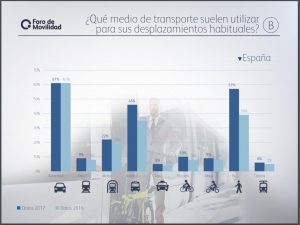
What does this have to do with carsharing? Given that each carsharing vehicle is used some 15 times per day, according to Fernando Izquierdo (from Emov), and a privately-owned vehicle only twice (usually the return trip to work), the same car makes 650% more trips and uses much less parking time when it is a carsharing vehicle. If we apply mathematics:
- By this rule of thumb, 500 of Zity’s Renault ZOE cars are the equivalent of some 3,750 privately-owned cars.
- 41% of drivers who in 2014 went to work by car took more than one hour to cover the distance, according to Nielsen consulting.
Putting these two sets of information together, we find that the carsharing vehicle is on the road practically the whole day (though obviously it will be in greater demand at rush hour, and the charge time also has to be taken into account), therefore occupying hardly any space in the city. Perhaps half the space of a privately-owned car, once carsharing becomes a widespread mobility option.
In other words, 500 carsharing vehicles provide the service of several thousand, but occupy the space of just a few hundred. It would doubtless be fun to perform the exercise of bringing into our present time two proponents of the capitalist and communist systems of the 19th century, respectively, and ask them to place the carsharing mobility option in one of the systems. It would obviously be somewhere between the two, using a technology which was unheard of even at the end of the 20th century.
This type of mobility, which is part of mobility as a service, or MaaS, is changing the way citizens move around in the cities in which it has been introduced. For long-distance journeys, well-known applications already exist under the MaaS umbrella (though not in carsharing), such as BlaBlaCar, which have spread rapidly amongst the younger population.
Electric mobility, the only possible option for the future
The last letter in CASE mobility is the E for Electric, perhaps the most important concept of all when talking about environmentally friendly solutions and a sustainable future. Although autonomous mobility and carsharing optimise assets and, as such, already constitute an important check on pollution, especially when considering factors external to manufacturing, it is the actual driving, kilometre after kilometre, that generates the largest amounts of COx and NxOy emissions.
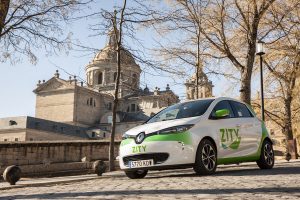
To be fair, it has to be said that electric cars also have an environmental footprint and impact, although it is not nearly as overwhelming as that of thermal vehicles (diesel, petrol, LPG, CNG…). In order to make an adequate comparison, emissions are usually measured ‘well to wheel’, i.e. taking into account the whole polluting cycle, from sourcing of the primary fuel to how that energy is used to power the vehicle.
Using figures from the manufacturer, and assuming that we powered Zity’s Renault ZOE cars by burning petrol to generate electricity, the car would have a footprint of 37.9 gCO2eq/km* in Spain, compared to 104.8 gCO2eq/km for the Renault Clio dCI (diesel version) and 117 gCO2eq/km for the Renault Clio TCe (petrol version). That is 67% less than thermal cars in the worst case, with the primary source of energy used being thermal.
*NOTE on CO2eq: grammes of CO2 equivalent are used to transform different sources of pollution, such as electricity generation, petrol or diesel, despite the fact that the impact in gas is different for each case.
When we use a clean source of energy, such as wind turbines or solar energy, the Renault ZOE has an impact of 0 gCO2eq/km. In other words, it causes no pollution at all while driving, except for the wear on the machinery itself, which will eventually need replacing. Such as the wear on the tires, for example.
But even the maintenance of an electric vehicle is much cheaper, simpler and less polluting than that of a thermal engine, which uses other elements such as engine oil, gearbox oil, oil filter, air filter, fuel filter, timing belt, fan belt, etc. The mechanics in an electric car are much simpler.
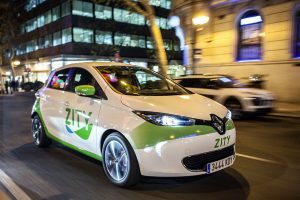
It’s not for nothing that most carsharing fleets and all 100% autonomous cars are electric, apart from the fact that maintenance is cheaper. If they are looking to the future, they must be powered by the future. Due to environmental pollution, health problems caused by air quality and the human impact on climate change, the European Union hopes to be thermal-car free by about 2050 by taking gradual steps:
- In 2019, a large number of European local councils, such as Barcelona, Madrid and Oslo, will ban thermal cars in the city centre.
- Cities such as Dublin, Brussels, Milan, Oviedo, Rome, London, San Sebastián… will follow in 2020-2022, especially in the UK and Italy, where 20 local councils have already confirmed this.
- In 2025, you will need to have an electric car to drive into Amsterdam.
- By 2025 it will no longer be possible to buy a thermal vehicle in Norway, where 100% of car sales will be electric, by law. Any petrol cars must be sold outside the country, with all the costs this involves.
- By 2030, there will be no thermal cars in Germany. Oliver Krischer, from the German Bundesrat (Federal Council) has said: “If the Paris Agreement is to be taken seriously, no combustion engines should be driving on our roads from 2030.”
- And perhaps France will follow in 2040. Nicolas Hulot, minister for Energy Transition, has said: “We hope to have phased out diesel and petrol cars by 2040”.
- And by 2050 no thermal vehicles will be driving in the UK. An agreement between all the political parties will make it impossible.
There’s still a long way to go from here to 2050, but a commitment by governments to such long-term decisions for citizens to breathe more easily is a great achievement from our democratic systems. And seeing fleets of electric vehicles in our cities is another luxury of our time.
Together with this, gradual automation (cruise control, adaptive braking technology, emergency brake, parking assistant, etc.) is taking cars ever closer to level 5 of autonomous driving, which is the level at which not even a steering wheel will be required.
Sharing in all of its forms (carsharing, motorbikesharing, bikesharing) is an element associated with the tow points made above, as are connected vehicles. All of these types of mobility, interdependent to a certain degree, come together in CASE mobility, which is getting closer to becoming a reality.





There are no comments yet